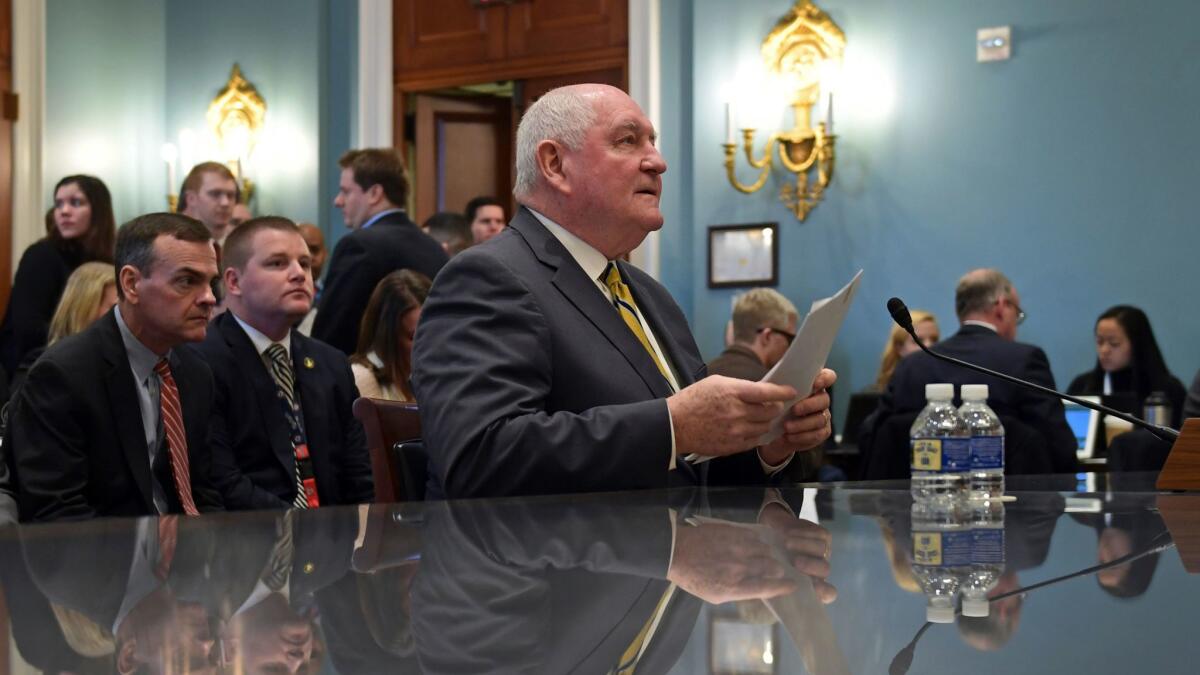Column: Trump’s plan to replace food stamps with food boxes is his meanest idea yet

For some reason, conservatives have always harbored a special hostility for the food stamp program.
House Republicans voted in 2013 to strip $40 billion from the program over 10 years, which would have thrown more than 3 million people off its rolls annually. They groused incessantly over a sharp increase in enrollment and spending from 2007 through 2012 (perhaps forgetting that a little thing known as the Great Recession occurred in that time span). They constantly try to legislate how recipients spend their benefits, fantasizing that they’re blowing their monthly check (average: $125.79 per person, or $4.20 a day) on lobsters and truffles.
Now comes President Trump, with the meanest and dumbest approach to food stamps in recent memory. Trump’s budget proposal, released on Monday, calls for replacing half of the monthly cash benefit for most recipients with a Department of Agriculture food box containing “shelf-stable milk, ready-to-eat cereals, pasta, peanut butter, beans and canned fruit, vegetables, and meat, poultry or fish.”
This new proposal ... would require operational capacity and infrastructure that neither USDA nor states now have.
— Stacy Dean, Center on Budget and Policy Priorities
The budget document calls this a “cost-effective approach.” In fact, it’s nothing of the kind. It’s likely to raise costs, rather than reduce them. But it’s being used to cloak the administration’s intention to cut the Supplemental Nutrition Assistance Program, or SNAP — to use the formal name of the food stamp program — by one-third, or $213.5 billion, over 10 years. (About 60% of the savings would come from the boxes, the White House asserts, the rest from narrowing eligibility for food stamps and placing a time limit on benefits.) The budget claims the food boxes will “improve the nutritional value of the benefit provided,” an assertion for which there is no evidence whatsoever.
The budget also labels the food-box idea a “bold new approach.” The truth is, it’s a tired old approach to government assistance programs that we previously have identified with the “undeserving poor” theme. The underlying notion is that people receiving government aid are layabouts and scammers with nary a concern in their bones except how to rip off honest working Americans.
As it happens, the promoters of this notion often are politicians who are digging into the public purse with both hands. Our favorite hypocrite in this vein is Rep. Doug LaMalfa (R-Richvale), who cast his vote for that 2013 cut in SNAP while enjoying the fruits of $5.1 million in government crop subsidies collected from 1995 through 2012 by his family farm. He said then that he couldn’t understand why “we can’t retract just a little bit of the spending [on food stamps] over something that’s grown exponentially in the last three or four years to try to get this reform in place.”
Harry Hopkins, who established the New Deal relief structure under President Franklin D. Roosevelt, understood the impulse to demean the poor, because he had spent years in social work watching the process unfold, to his disgust. The mindset of relief workers in that era, Hopkins observed, was that “the applicant was in some way morally deficient [and] must be made to feel his pauperism. … Every help which was given him was to be given in a way to intensify his shame.”
One recurrent approach was to dictate how recipients spent their benefits. Hopkins abominated the system. “It is a matter of opinion,” he said, “whether more damage is done to the human spirit by a lack of vitamins or complete surrender of choice.”
Trump aides have strained every sinew to make the food-box idea seem innovative and efficient. It hasn’t been pretty. White House budget director Mick Mulvaney called the proposed change “a Blue Apron-type program where you actually receive the food instead of receive the cash.”
Bad comparison. Blue Apron is a tech start-up that delivers ready-to-cook gourmet meal boxes to your front door. But it’s hardly a raging success, much less a model for government to emulate: The company has never turned an annual profit and has been losing customers by the cartload. Its stock has lost about two-thirds of its value since its $10 initial public offering last June, which was a disappointment at the time.
Efficiency? The budget says states would have “substantial flexibility in designing the food box delivery system through existing infrastructure, partnerships, or commercial/retail delivery services.” But Agriculture Secretary Sonny Perdue acknowledged in a fact sheet issued with the budget that distributing the “USDA Harvest Boxes” would cost states about $2.5 billion annually in new administrative costs. That’s probably an understatement.
“This new proposal,” said Stacy Dean of the Center on Budget and Policy Priorities, “would require operational capacity and infrastructure that neither USDA nor states now have.” If recipients have to travel to a central distribution point, that’s an additional cost imposed on them.
Food assistance experts noted that nothing in the budget document explains how the food boxes would be assembled to ensure that they meet the needs of client families. The blanket statement that they would improve the nutritional value of the food stamp benefit implicitly assumes that families aren’t shopping wisely. Moreover, milk, peanuts, and wheat, all of which are prominent components of the boxes, are among the most common allergy triggers, especially in children. Did anyone in the administration put any thought into what makes up the “Harvest Box”? Or did they just wing it?
USDA rules already prohibit using food stamps for beer, wine, liquor, cigarettes or tobacco, food to be eaten in the store or precooked hot items. The agency traditionally has counseled against imposing further restrictions on food stamp purchases. USDA data generally show that the diets of food stamp recipients are essentially identical to everyone else’s. “Food stamp recipients are no more likely than higher income consumers to choose foods with little nutritional value,” the USDA reported a decade ago. “Thus the basis for singling out low-income food stamp recipients and restricting their food choices is not clear.”
That judgment was issued back when the USDA was a responsible federal agency, not a tool to impoverish needy Americans. Political experts are saying that the Trump budget is just a fantasy document, dead on arrival on Capitol Hill. But Americans ignore the underlying themes at their peril.
The mystery is where the food-box idea even came from, because it’s cartoonishly mean-spirited, complicated and costly to administer, and utterly unnecessary. One imagines people such as Mulvaney and Perdue stalking the halls of the White House and the USDA in a stupor, their brains filled with incoherent ideas about how to make the lives of Americans worse.
Keep up to date with Michael Hiltzik. Follow @hiltzikm on Twitter, see his Facebook page, or email michael.hiltzik@latimes.com.
Return to Michael Hiltzik’s blog.
UPDATES:
2:46 p.m.: This post has been updated with information about the allergenic nature of some foods in the USDA box.
More to Read
Sign up for Essential California
The most important California stories and recommendations in your inbox every morning.
You may occasionally receive promotional content from the Los Angeles Times.











